Advances in Motor Neuroprostheses » książka
topmenu
Advances in Motor Neuroprostheses
ISBN-13: 9783030387426 / Angielski / Miękka / 2021 / 162 str.
Advances in Motor Neuroprostheses
ISBN-13: 9783030387426 / Angielski / Miękka / 2021 / 162 str.
cena 603,81
(netto: 575,06 VAT: 5%)
Najniższa cena z 30 dni: 578,30
(netto: 575,06 VAT: 5%)
Najniższa cena z 30 dni: 578,30
Termin realizacji zamówienia:
ok. 22 dni roboczych.
ok. 22 dni roboczych.
Darmowa dostawa!
Kategorie BISAC:
Wydawca:
Springer
Język:
Angielski
ISBN-13:
9783030387426
Rok wydania:
2021
Wydanie:
2020
Ilość stron:
162
Waga:
0.25 kg
Wymiary:
23.39 x 15.6 x 0.97
Oprawa:
Miękka
Wolumenów:
01
Dodatkowe informacje:
Wydanie ilustrowane











